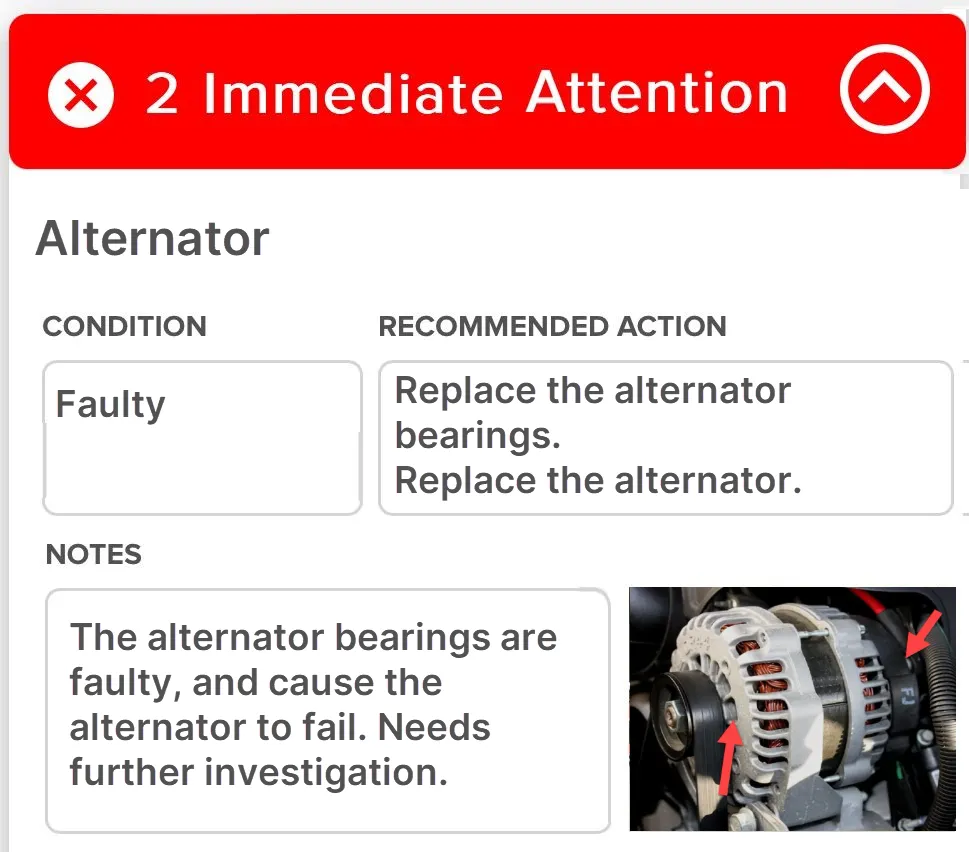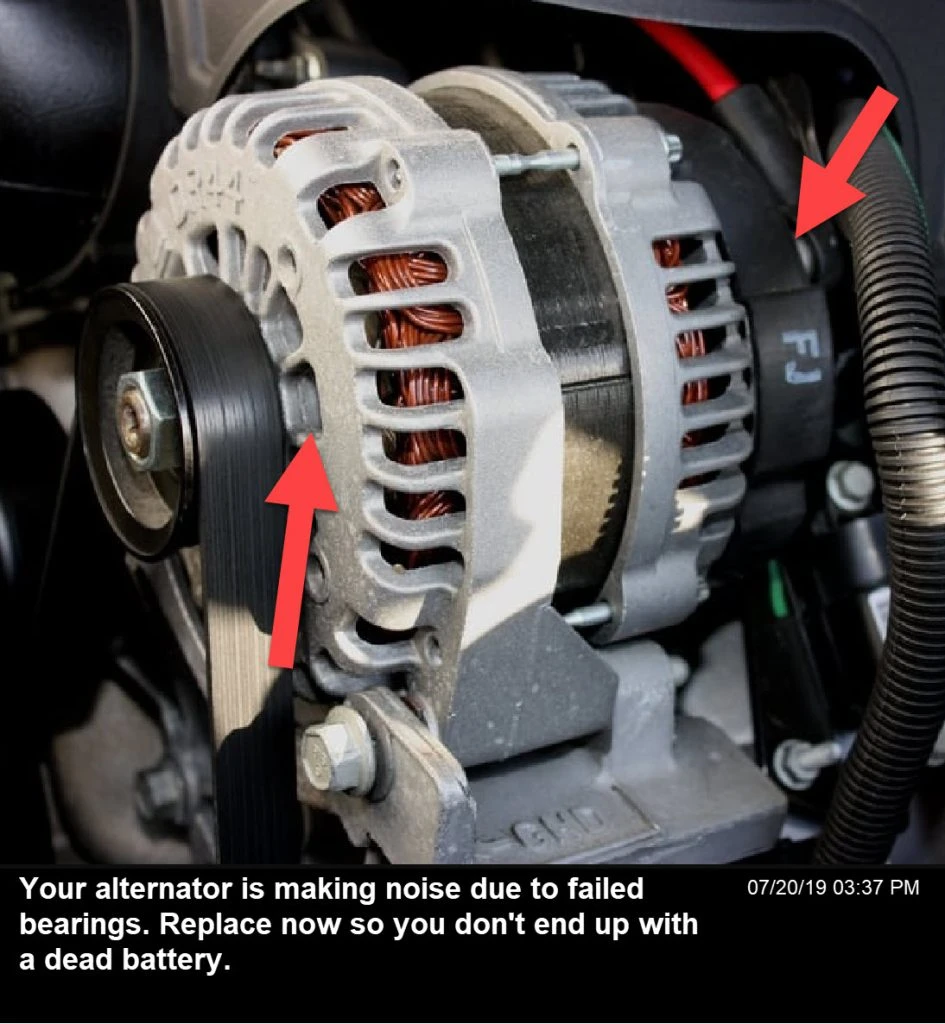
The alternator is vital to keep all your vehicle's electrical accessories working properly. If it goes bad, a single alternator replacement probably won’t fix the vehicle’s issue due to other electrical failures that might have caused it to go bad in the first place.
When browsing online, you’ll find the average cost for an alternator replacement is between $600 to $800 for non-European car brands like Chevrolet, Toyota, Ford, etc.
For higher-end vehicle models though, like a 2023 Chevrolet Camaro, the range can sit around $1300 - $1500.
Here are the main prices you’ll find online for an alternator replacement in these popular vehicles:
- 2019 Chevrolet Tahoe: $402 - $635
- 2020 Ford F-150: $1123 - $1650
Alternator replacement cost: What affects the final price?
There are two ways a shop can quote you on alternator replacement service. The first is if you only ask for a replacement. The second is if you ask for a fix to prevent the problem from returning.
Here are the common costs if you ask only for an alternator replacement:
-
The labor rate: Labor rates change between professionals (ASE technicians charge more than rookie mechanics), and regional wage differences.
-
The shop’s neighborhood/area: Areas will determine the replacement cost. For example, Santa Barbara in California has different prices than Albuquerque, in New Mexico; this could be due to lease rates, cost of living, etc.
-
The vehicle type: European brands like Mercedes, BMW, Audi, etc., have different prices for alternator replacement. For example, an Audi alternator replacement can typically start at $1400 and go above $1500, based on online estimates that do not account for your vehicle's condition and tailored solution.
-
OEM vs Aftermarket: Original Equipment Manufacturer (OEM) alternators are made by your vehicle’s original manufacturer, therefore they’re more expensive. Aftermarket alternators, which aren't branded by your vehicle’s manufacturer (even though they may come from the same supplier) are less expensive. Aftermarket parts will commonly have double the warranty time, though. Still, OEM is what your vehicle was equipped with, and might be the path back to OEM specifications.
- Part technology: Some vehicles may have A/C outlets by the alternator, which also changes the alternator price. Plus, there are also amp differences (some may be 150 amp, others 170 amp, and so on).
How does the alternator replacement return my vehicle to healthy conditions?
If your alternator went faulty because of common wear, meaning nothing else was forcefully damaging it, an alternator replacement returns the vehicle to good working condition.
But, you can’t be sure if your vehicle stays healthy without at least a charging system inspection. The inspection gives mechanics the confirmation whether only an alternator replacement takes care of everything, or if a deeper process is best.
The inspection needs to focus on the charging system because the alternator is part of it.
What exactly is a charging system inspection?
The charging system inspection is a paid “detective work” where mechanics note and record everything that’s not working as expected in your charging system.
-
Mechanics inspect the vehicle, noting everything about the alternator’s performance and searching for any issue causing extra wear on the alternator.
-
They show you their observations and propose suggested repairs to get the alternator working 100%.
-
They do a quote for the suggested repairs.
The proposed repair after the inspection might be just an alternator replacement if nothing else was causing damage. But, if the main problem is not just normal alternator wear and involves other systems, the suggested quote will increase.
Here are the routes you can go based on your options.
-
Alternator replacement: This means you want the alternator replacement and nothing else, so you’ll probably only pay for common replacement costs. The downside is that you might not discover what caused the alternator to go bad in the first place. Assume there’s a problem somewhere else in your car that’s damaging the alternator. In this situation, a replacement won’t solve the issue, it might just make you return to the shop soon to replace the alternator again.
-
Long-lasting fix: This means you want to permanently fix your vehicle and understand what might be wrong with it. So, you want to investigate if there’s an issue causing your alternator to wear down faster than expected, and if there is, you want to eliminate it. You’re willing to spend more money to cover extra processes that ensure your car runs reliably for good.
Why have a long-lasting fix? The short answer is to save money and stress while ensuring the vehicle is good for the next thousands of miles. A long-lasting fix has the goal of not having you return to the shop for a really long time.
If the alternator problem is being caused by something else, replacing the alternator is like painting over mold. For vehicles, electrical and charging issues can progress and even affect the car engine; it's best to avoid that.
How much can a long-lasting alternator fix cost?
A long-lasting fix has factors changing the final price. Here’s what you can expect:
-
Charging system inspection: A charging system inspection can cost around $120 to $150, but it varies depending on the vehicle's system design. This is an investigation of your charging system involving the labor of service advisors and mechanics to discover issues/due repairs.
-
Component replacements: The inspection indicates other worn components in the charging system that require replacement. This depends on the specific condition of the vehicle.
-
Other systems repairs: The shop might find other malfunctioning systems requiring parts replacements and/or computer reprogramming, affecting the cost range. For example, replacing a faulty battery, serpentine belt, and wiring because they’re stressing the alternator can add more costs to the final quote. In worst cases, costs can go north of $2000.
How to get transparent long-lasting repairs
If you want to:
-
Investigate your faulty alternator: Discover if something is damaging it and risking the electrical and charging systems.
-
Fix the whole problem: If something damages the electrical and charging systems, fix it so it doesn’t return anytime soon.
-
Save time and stress: Drive with peace of mind, knowing your alternator is 100% safe and you’re far from visiting the shop because of it again.
Then, relying on online estimates is MISLEADING. Online estimates only price the alternator replacement, and won’t consider whether you want a long-lasting solution. The solution for your alternator failing is specific to your vehicle.
How to spot shops that do transparent long-lasting repairs? The best way to get a precise estimate is to seek shops with a certified “transparency process” to perform a charging system inspection for you. Their transparency relies on documenting everything about your car's electrical system condition and clarifying their findings with edited images and videos of your car.
Let’s see an example of a transparency-focused alternator repair.
A transparent, long-lasting alternator repair example
A full charging system inspection’s main goal is to discover the charging system’s condition, investigate chronic issues, and check if all charging components work as expected.
For instance, if a shop is requested to do a charging system inspection due to a faulty alternator, the mechanics examine everything related to the system, starting from the battery.
They’ll check every charging component for signs of wear, tear, or leaks to find if something prevents the alternator from working as expected. The inspection may reveal the need to replace various components and identify anything causing extra wear on the alternator.

For example, if mechanics find faulty alternator bearings, causing noises and leading to premature wear, they mention it in the inspection.
In this case, the mechanic put the “Immediate Attention” tag on the bearings and alternator since they might quickly cause extensive damage. This means the two main priorities are to fix the bearings to eliminate the extra wear and replace the alternator.
The final quote also suggests replacing naturally worn charging components they’ve spotted during the inspection.
Why this level of transparency?
These businesses want to help you make the right decisions by providing education about your car so you can budget for the necessary repairs at current and future visits. It’s cost-beneficial for you and the auto repair facility.
Why is it cost-beneficial for you?
They won’t simply fix your problem. They’ll make sure it doesn’t return for thousands of miles.
Why is it cost-beneficial for them?
Most of these shops want to keep you as a customer for life. They want people to trust and recommend them, strengthening their bond with the community and growing their businesses.
The “find shops providing a DVI” method
Fortunately, you can have that level of transparency beyond the charging system inspection. The so-called DVI method leads you to shops offering a transparent vehicle health check-up.
This method focuses on two things:
-
Does the shop have a modern DVI?
-
Does the shop have certifications?
What’s a DVI? As mentioned earlier, It’s like an annual physical visit to the doctor to assess the body’s vital signs, but for a car instead; most auto repair shops don’t charge to do it. The DVI regularly creates your vehicle’s “state of health,” explaining its overall condition.
The mechanic uses the DVI results to inform the conditions of your vehicle’s systems and the recommendations to get it running reliably. If they find issues, they’ll list them in order of priority.
Let’s see an example of how the DVI can help with an alternator replacement:
A DVI helps with an alternator replacement
The DVI starts with the mechanic checking vehicle systems (wiring, bearings, connections, etc.) for signs of wear/tear/leaks. They’ll document everything through notes, videos, and pictures.
Here are some important things about a DVI:
-
It’s a visual inspection: The mechanic looks at the car’s component’s surface, searching for obvious problem signs.
-
It also checks for noises: The mechanic listens to your car sounds and points out unusual noises.
-
It does not include further testing: A DVI doesn’t mean in-depth tests and investigations, it’s a surface-level report that indicates if a car needs repairs or deeper inspections.
If they spot alternator issues, they’ll edit images and videos to indicate points of concern (damages, leaks, components’ locations, etc.) surrounding the alternator. They’ll highlight their findings using arrows, circles, and text.
Note that the DVI doesn't involve additional testing, so the advisor will be taking notes based on what he/she sees (visual inspection). In the image below, the mechanic found that the alternator was failing due to a faulty bearing.

A document with the vehicle’s health status is sent to the customer, with room for questions through online/phone or over-the-counter communication. The customer sees what repair priorities their vehicle has and what should be checked in the near future.
In this case, they’ll see an alternator and bearing replacement priority. The focus is to educate and help the customer make informed decisions about their car.
Certifications that help you
Today’s auto industry has certifications for customer-educational and transparent businesses. For example, the AutoTechIQ certification makes shops that fit into the DVI method stand out on your local map. So you can find the one closest to you.
The shops with an AutoTechIQ certification typically feature 100+ excellent Google reviews! You can quickly find this certification on a shop’s website or using AutoTechIQ’s “Find a shop” map.






